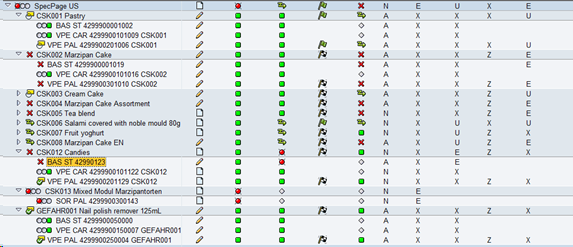The GS1 pool may also detect an error in the product, which can be corrected in the CIC display.
In the following example, there is an error in the “Country of Origin-Farming“ field; the field content is DE, but it should be represented as 276.

After the data has been corrected and the pool has been refreshed, Synchronisation is reported. At this point, retailers send a CIC-message with Synchronised on the published GTIN(s).
For a Synchronised product, there will be a response from the individual retailers on the display:

The material should then receive a Synchronised response from all the retailers:

If there are missing retailer names in regards to synchronised material, you can correct this empty field. Maintenance of this field can be done in two ways.

First, the trade chain can be entered manually by double clicking (labeled 1) on the empty field and typing the name (labeled 2).
Otherwise, you can delete the trade chain entry if it is not relevant to you with a subsequent status update. The material will be switched to the status Synchronised.

1)Select the row to be deleted.
2)Click the Trash button. Click Yes in the new popup window to confirm deletion.
3)If the deletion is confirmed, exit the CIC-Monitor by clicking ![]() .
.
4)Refresh the status to Synchronised by clicking ![]() .
.
In the dialogue field of the GTIN-Connector©, you can select individual status information, which is displayed by clicking ![]() in the GTIN:
in the GTIN:

The priority of the status within a process designates which status is valid for the higher ranking hierarchy level (an arbitrary level of the Hierarchy Tree).
In the example below, the priority of the error (=1) is higher than the successful examination (=4), so the whole packaging hierarchy receives the validation status ![]() . The combination of the individual status information for every process is consolidated into a group status and displayed as a leading symbol in the Hierarchy Tree.
. The combination of the individual status information for every process is consolidated into a group status and displayed as a leading symbol in the Hierarchy Tree.

Group Status of a GTIN
Generally, those that are designated for a PID status (and symbols) are, in turn, maintained in the /GLN/S2_ST1CUSTV table. The process is as follows:

Due to the fact that only the icon is displayed in the GTIN-Connector©, the definition has an informative character for Customizing. As there are a plethora of possible status combinations, there would also be an equal number in the group status. However, it is recommended that you limit yourself to a minimum amount and that you render the combinations for similar clusters with the same group status.
The actual designations of the occurring combinations, takes place in the /GLN/S2_STCUST table (transaction SM30), pictured below.

The result in the GTIN-Connector©:

In theory, it is assumed that more than 1000 status combinations are possible, of which most of them would and/or could never occur in a standard company. It is therefore not necessary to maintain all combinations. Should an undefined combination occur, then the group status will be set to ![]() and can be easily maintained in Customizing, retroactively.
and can be easily maintained in Customizing, retroactively.